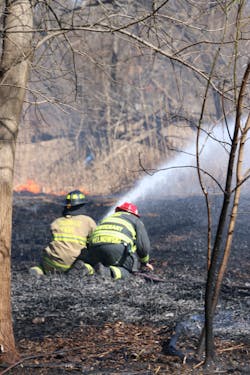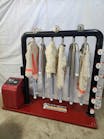Research Corner: Structural PPE in the Wildland Environment
Significant attention and research has been given to the protective gear that a firefighter wears. Gear needs to provide a level of protection against the overall thermal environment and products of combustion. Additionally, the gear needs to provide abrasion protection, resistance to bloodborne pathogens, and a level of water and liquid repellency.
NFPA 1971: Standard on Protective Ensembles for Structural Fire Fighting (2013) establishes the minimum requirements for PPE. Firefighters have bemoaned the weight and isolative properties of modern PPE but have found it increasingly necessary due to the thermal environment within a modern structure fire. However, the very gear that is designed to protect the firefighter from the hostile environment of a structure fire also imposes a physiological burden.
Urban meets wildland
A project recently completed at Skidmore College’s First Responder Health & Safety Laboratory that was designed to evaluate the use of technology to monitor the physiologic impact of firefighting took an unanticipated twist related to the impact of heat stress. The research team, which included a number of fire service partners, worked with the Hanover Park, IL, Fire Department to test technology options in a “real-world” environment. The study, titled SMARTER—Science, Medicine And Research, Technology for Emergency Responders—had firefighters wearing physiological status monitoring (PSM) devices to capture their heart rate, activity and estimated core body temperature. The project was funded through a FEMA Assistance to Firefighter Grant Program (EMW-1015-FP-00731). (Learn more about the project in the Firehouse supplement “SMARTER: Advancing Health-Related Technology” at firehouse.com/21037683.)
When the research team partnered with Hanover Park to evaluate the usefulness of the PSM during fire department operations, it was implicitly assumed that the focus would be primarily on structural fires and other types of emergency incidents. The study did not anticipate evaluating responses to wildland firefighting. Hanover Park is a suburban department located in the Chicago metro area and rarely responds to wildland type incidents. However, 2017 proved to be different in that the department managed three fairly large wildland incidents early in their calendar year.
Since Hanover Park rarely handles these types of calls, personnel are issued structural PPE. Like many departments, the cost associated with the purchase of both structural PPE and wildland PPE is weighed against the number of responses in which the specialized gear would be needed. The physiologic findings discovered while personnel conducted wildland suppression efforts while being monitored, as part of the SMARTER study, provided valuable information that showed the need to reevaluate the cost/benefit equation.
Case review
This question of appropriate gear is not new. Departments for many years have wrestled to find the appropriate balance between the cost of providing specialized gear and the risk of excessive heat strain during wildland fires. This prolonged struggle has likely resulted in many heat stress-related illnesses and injuries, as fire departments have not been able to justify an additional set of gear.
One of these tragic incidents that highlights the seriousness of the decision about gear, and how long it has been a problem, occurred on Sept. 6, 1990, when 25-year-old Firefighter Todd David Colton of Sedgwick County, KS, Fire District 1, died in the line of duty due to heat stroke.1
Colton and his captain responded to a field fire caused by a resident burning trash. The ambient temperature at the time of the alarm was 95 degrees F with sustained, and sometimes gusting, winds between 17 and 28 mph. Colton wore full structural PPE that included a turnout coat and bunker pants. On arrival, he and his captain deployed and operated two 200-foot booster lines for nearly 60 minutes. The captain reported that the two continued working until they were both exhausted. The captain then told Colton to remove his PPE, get a drink of water and rest while he walked to the command post to discuss the incident with the responding assistant fire chief. 1
Due to several issues, commanders lost track of Colton and his body was later discovered in an unburned brush covered area, dressed in full PPE, approximately 4 hours after his arrival at the scene. The Sedgwick County Coroner ruled the cause of death to be heat stroke. Contributing factors listed were high ambient temperatures, high radiant heat, and the performance of heavy work while wearing PPE.1
Wildland situation
The question of how best to protect firefighters at wildland incidents is an especially timely matter as departments nationally are experiencing an increasing number of wildland fires. More specifically, wildland/urban interface (WUI) fires are more frequent and providing an increased challenge for firefighters equipped and accustomed to structural operations. Since 1990, 60 percent of all new homes have been built in areas considered WUI. The U.S. Forest Service identifies the WUI as “places where built structures abut or intermingle with undeveloped natural areas.” Over the last decade, the fire season has become 2½ months longer, and fires covering more than 10,000 acres are increasing.2
In addition to the challenge that many fire departments have with the WUI, many Midwestern and Great Plains departments experience significant agricultural field fires. These fires are often sparked by harvesting equipment and can produce substantial fire losses to expensive equipment and cash crops that are destroyed and will not ultimately reach market. Many departments that have historically viewed themselves as structural firefighters are now tasked with responding to these types of incidents. Statistics from the NFPA related to brush, grass and forest fires suggest that, nationally, departments respond to just over 900 of these types of incidents each day. In 76 percent of these incidents, they were managed by local fire departments requiring no assistance from state or federal forestry agencies.3
Physiologic findings
At the wildland incidents handled by Hanover Park, personnel responded wearing structural PPE. In addition to structural PPE, firefighters wore a base layer shirt manufactured by Globe or a strap that is equipped with Zephyr WASP (wearable advanced sensor platform) physiologic monitoring technology. Physiological status was captured using the WASP system and was transmitted to on-scene monitoring equipment.
During the first of the Hanover Park incidents, firefighters responded on Feb. 14, 2017, at 4:06 p.m. to a field fire in a county-owned forest preserve. Two companies were originally dispatched to this incident, an engine (three personnel) and a firefighter-paramedic ambulance (two personnel). They found fire quickly advancing over open vegetation driven by 18-mph winds. The ambient temperature was 45 degrees F with a humidity level of 56 percent.
Firefighters ranged in age from late-20s to late-30s, with the oldest responding member being the engine company lieutenant at 39 years old.
Data collected indicates that these responders had peak heart rates ranging from 159 to 205. These rates indicate that firefighters were at or near maximum heart rate at various times during the incident. Similar numbers have been seen during laboratory testing and are not overly concerning for personnel who are in good health and do not suffer from an underlying cardiac condition.
More concerning, however, was the high peak estimated core body temperatures. Core temperatures are estimated via the WASP technology by using a calculation developed by Dr. Mark Butler of the U.S. Army Research Institute of Environmental Medicine. Butler originally developed this algorithm using military personal. An important objective of the SMARTER project is to update and tone this algorithm to ensure that it accurately estimates core temperature responses in firefighting situations. The non-invasive assessment of core temperatures being readily available to incident commanders (ICs) has the potential to assist in fireground decision-making.
At this incident, estimated peak core temperatures for the initial attack firefighters were 103.1 degrees F, 102.2 degrees F, 101 degrees F and 99.28 degrees F (one WASP device malfunctioned, so no data is available for this firefighter).
A generally accepted standard for defining heat stroke is a core hyperthermia above 104 degrees F.4 We understand from prior laboratory research that even when firefighters are removed from the hot environment and their PPE is doffed, it is common for their core body temperatures to continue to rise. Taking this factor into account, it is easy to determine that firefighters responding to this incident were, at least in one case, very close to meeting the clinical definition of heat stroke. Additionally, of great importance is the fact that the ambient temperature at this incident was 45 degrees F. As the ambient temperature increases, the risk of heat-related illness increases dramatically.
Based on the availability of this real-time data, the IC made the decision to pull the firefighter with the highest estimated core body temperature and send him for immediate rest and hydration, which also included doffing of PPE. Note: It is understood that it is not always possible to remove a firefighter from an assignment based on physiological conditions, as they may be entrenched in duties that they can’t abandon, such as making a rescue, advancing and operating a hoseline, etc. In these situations, likely the best an IC can do is simply see that the firefighter is being stressed and give them additional resources to ease the workload.
Future gear considerations
The findings from this incident highlight the logic of having firefighters operate at wildland incidents wearing structural PPE when the overall thermal protection offered by these garments is not required and can be physiologically detrimental.
The cost associated with equipping and maintaining firefighters in current NFPA standard PPE is high and very challenging for many agencies. Many departments opt for structural PPE as their only source of protection since this reflects the majority of their fire work and because it provides maximal protection. They also require the usage of this same PPE for all other incidents requiring a level of protection, such as vehicle crashes, extrications, structural collapses, technical rescues, etc. The question is, does this make sense?
Within the Hanover Park Fire Department, the cost associated with wildland gear has not been justified due to the low number of wildland calls; however, as we considered the findings from SMARTER, we are beginning to question whether wildland gear could be used for other purposes that might be a modifier to the economic decision.
Based on this, Hanover Park and Skidmore are currently evaluating a wildland pant and coat (i.e., non-structural PPE) configuration that provides flash/abrasion/bloodborne pathogen protection. This study, approved by the Skidmore College Institutional Review Board (IRB) and funded by the Hanover Park Fire Department – Foreign Fire Tax Insurance Board, will allow us to compare the physiologic responses of firefighters working in structural PPE vs the non-structural gear.
Final thoughts
The financial impact associated with firefighters being issued two sets of PPE (one structural and one non-structural) may be cost-prohibitive for many jurisdictions. However, the corresponding reduction in heat-related illness/injuries and associated costs may contribute to an analysis for possible change. At this point, the change in PPE is a theory that requires additional research and analysis. Should our hypothesis prove to be correct and the lighter-weight gear provides a decrease in the negative impact of heat stress while still providing an acceptable level of protection, it has the potential to help solve this challenging dilemma and work to prevent incidents like the one befallen Sedgwick County and the Colton family.
In a statement remembering Firefighter Colton, the Sedgwick County Fire District website reads, “The best way we can honor Todd Colton and the Colton Family’s sacrifice is to take every possible step to keep the same accident from happening again.”5
The SMARTER team is using information gained from the project to make informed, data-driven recommendations about appropriate protection for fire service personnel.
References
1. Shults, R, Noonan, G, & Turner, N. “National Institute of Safety & Health—Firefighter Death Investigation (T.D. Colton).” HETA 90-0395-2121. 1991. Cincinnati, OH: NIOSH.
2. Weber, T. “Wildland-urban interface risks are increasing.” ISO Mitigation. 2016. isomitigation.com/spring-2016/wildland-urban-interface-risks-are-increasing.html.
3. Ahrens, M. “Brush, Grass and Forest Fires.” NFPA - News and Research. 2018. nfpa.org/-/media/Files/News-and-Research/Fire-statistics-and-reports/WUI/osbrushgrassforest.pdf.
4. Mayo Clinic. “Heatstroke.” 2017. mayoclinic.org/diseases-conditions/heat-stroke/symptoms-causes/syc-20353581.
5. Sedgwick County, Fire District 1 – In Memoriam. “Fallen Members.” 2018. sedgwickcounty.org/fire/memorial.asp.
Dr. Denise Smith
Dr. Denise Smith is a professor at Skidmore College and a research scientist at the Illinois Fire Service Institute (IFSI). She conducts research on the heat stress and cardiovascular strain associated with firefighting, pathoanatomic cause of firefighter fatalities, and strategies to increase performance and decrease cardiovascular events in the fire service.
Craig Haigh
Craig A. Haigh is chief of the Hanover Park, IL, Fire Department and an Instructor with the Illinois Fire Service Institute (IFSI). He is a regular research partner with Skidmore’s First Responder Health & Safety Laboratory. Haigh has a bachelor’s degree in fire and safety engineering, and a master’s degree in executive fire service leadership.
Andrea Wilkinson
Andrea Wilkinson, MS LAT/ATC, serves as project manager for the First Responder Laboratory at Skidmore College. She is certified and licensed in athletic training and cardiac rehabilitation, and has extensive clinical experience in cardiac care and sports medicine. Wilkinson has a special interest in preventative medicine for the tactical athlete.






